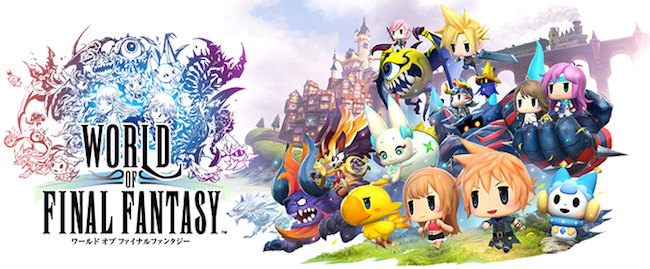
Developed as a collaboration between Tose and Square Enix and based around the idea of creating a Final Fantasy game suitable for a wider and younger audience to contrast against the increasingly mature tone of the mainline series, World of Final Fantasy (WoFF) is a concept that immediately piqued my interest as a longtime fan of the series. There has been a lot of debate amoung fans in recent years about the mainline series’ shift toward more action-orientated gameplay, so I’d like to think of WoFF as a heartfelt gesture from Square Enix towards those longtime fans who prefer turn-based combat.
I’m not short on nostalgic feelings toward the Final Fantasy brand, much less older JRPGs in general, so almost everything about this game appealed to my sense of nostalgia. There’s just one thing I really didn’t like about it going in, and that’s the chibi character art. I know it’s not a huge deal, but it’s simply not the way I personally wanted to see all my favourite Final Fantasy heroes come together. I do have to admit I’ve warmed up to this style over the years due to several excellent JRPG outings on the 3DS; most notably Bravely Default, which this game clearly derives inspiration from. And so, after watching a story trailer which gave off some Kingdom Hearts-esque vibes and learning more about its Pokémon-like gameplay and unique battle mechanics, I found myself moving beyond my superficial biases to give WoFF a real chance.
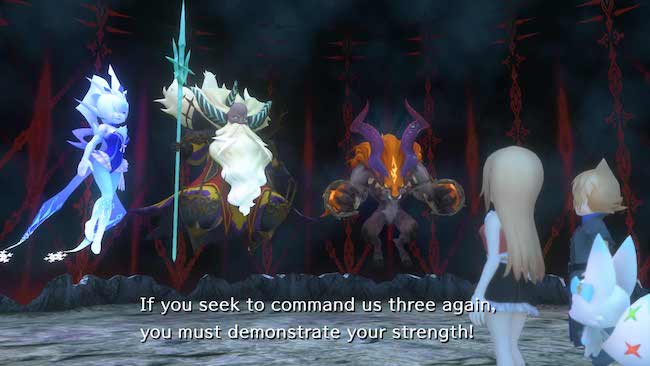
At its core, World of Final Fantasy is a trope-driven, sometimes confusing, but more often than not endearing adventure set around twin protagonists Lann and Reynn, who both suffer from amnesia and hold the power in one of their arms to capture and wield monsters known as Mirages. The main cast is likeable enough; although, Lann (the brother character) is intentionally not very bright and often walks a fine line between being comedic and annoying.
The game opens with the pair waking up in a strange place called Nine Wood Hills where they are told by a mysterious woman named Enna Kros that they must use a portal to return to the world of Grimoire if they’re to regain their memories. Accompanied by a magical fox-like guide named Tama (who for some reason has a weird dialogue quirk where she consistently misuses the word “the”), the twins learn that they once used to be powerful Mirage Keepers and agree that the best way forward for them now is to try and recapture as many as possible.
While the initial premise is vague and slowly driven forward by a series of underlining JRPG tropes based around wibbly-wobbly, timey-wimey type plot devices (some of which require an a special dictionary of made up words to fully understand), the sub-narrative taking place in the world of Grimoire is much more straightforward. The people who inhabit the world of Grimoire are chibi-like in appearance and are called Lilikins, whereas the twins in their natural, more equally proportioned form are known as Jiants. The gist of the story it is that Jiants are no longer common in Grimoire outside of the Bahamutian Federation, who are an oppressive force trying to conquer the world by means of forceful takeover or by offering protection to unswayed towns or cities with social-political incentives.
As not to alarm the locals, Lann and Reynn are given the ability to swap their appearance at will between Jiant and Lilikin—which plays a much bigger role in combat than it does the story. However, it’s not long before they’re found out by Princess Sarah of Cornelia (Final Fantasy I), and are told about a prophecy which talks of “Jiants from the Hills” who are destined to alter the course of Grymoirian history by either delivering salvation or ruin. While there is some scepticism at first, it quickly becomes widely accepted that the prophecy must be about Lann and Reynn. And so, in addition to trying to gain more power by capturing Mirages, the twins set out on a quest to collect four mystical keys hidden throughout Grimoire; all the while teaming up with various characters from the Final Fantasy universe to achieve their goal and thwart the efforts of the Bahamut Army and the big bad, King Brandelis.
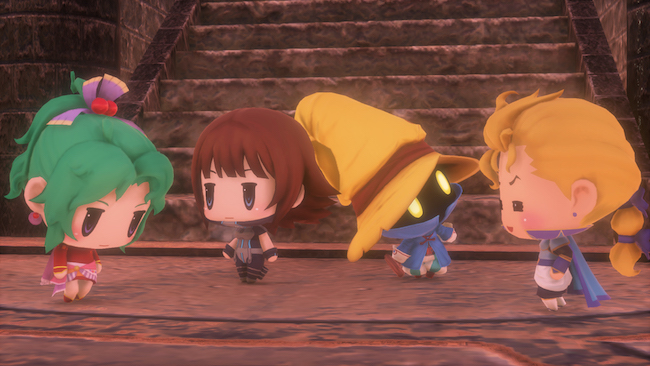
If not for witty writing throughout, it’d be pretty easy to shrug off the main plot as mostly forgettable. The game loves to break the fourth wall and share inside jokes with fans, which I personally loved, but I still struggled to get past the fact that a vast majority of the narrative is just a series of unremarkable events leading the player on a linear path from one Final Fantasy cameo to the next. The lighthearted tone certainly helps as the game never takes itself too seriously, but its best moments too often rely on your familiarity with the source material.
As a fan, it’s hard not to be overly forgiving when you get to witness iconic Final Fantasy characters such as Squall and Cloud or Edgar and Vivi interacting with each other and working together for the greater good—even if they’re all cutesy looking and reimagined to fit into the world of Grimoire. The game is absolutely dripping with fan service; which is fantastic for those who can appreciate it, but I’m not convinced WoFF has a lot of value for newcomers outside of its Pokemon-like appeal, which contradicts half of its reason for existing.
Depending on your perspective, WoFF will either feel wonderfully nostalgic, delivering the sort of gameplay fans know and love from older entries in the series, or it will come across as very dated and full of frustrating mechanics that no longer feel relevant in modern game design. The way I see it, WoFF was purposely designed around delivering a classic Final Fantasy experience with a modern twist, so for older fans such as myself, many of the mechanics which are considered dated by today’s standards didn’t bother me too much. I also like that the game took leads from Bravely Default by implementing a fast forward option—which you’ll absolutely want to use as the dialogue can get very long winded at times. An option to disable random encounters would have been nice, too, though, considering the frequency seems to be higher than average, which can get particularly frustrating later in the game.
My biggest issue with WoFF, however, is not actually pertaining to the hurdles that arise when a game relies too heavily on nostalgia, but rather how shallow the world of Grimoire is, and how it’s basically devoid of almost any meaningful exploration. It’s very easy to get caught up in the game’s underlining charm and all the fan service on offer, but when you take a closer look at how it’s been pieced together, the structure is alarmingly similar to the now critically reviled Final Fantasy XIII, and I’m honestly shocked no one is talking about this.
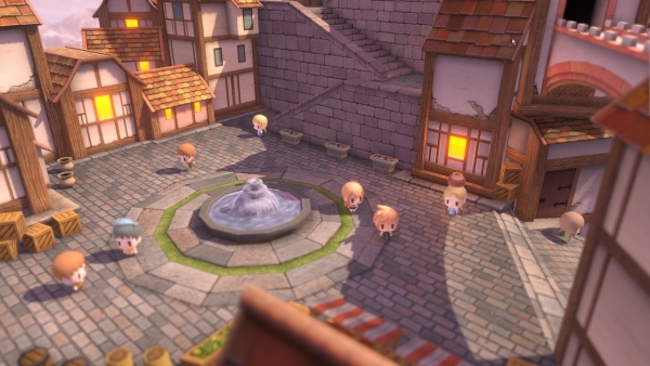
I think it’s important first to acknowledge that WoFF is built around an excellent battle system and supporting mechanics. If you’re a fan of Final Fantasy X, you’re going to feel right at home. This new modified ATB battle system has a lot in common with the one in FFX, and the progression system for Mirages is very similar to the sphere grid. As a diehard fan, just the concept alone of capturing a “Babyhemoth” and transfiguring (evolving) it into a Behemoth is a cool enough. Although, I honestly do believe that WoFF rivals Pokémon in some areas.
The game gives you a lot of flexibility with upgrading your Mirages, and I enjoyed the concept of creating “stacks” which lets you combine the abilities of up to two Mirages of different sizes along with Lann and Reynn. This is where the aforementioned ability comes into play where the protagonists can switch between Lilikin and Jiant forms. When creating a stack, there are three different sizes you can build with: small, medium and large, and you must use one of each. As Jiants or Lilikins, the twins makeup either the large or medium parts respectively. In addition to this, when you add two other mirages to your stack, you not only take on their abilities in battle but also combine stats and compound your magical abilities. For example, two Mirages with Fire will compound into Fira. It’s a fun system, and the game encourages you to develop a variety of Mirages in order to unlock items known as “Mirajewels” which are the only abilities which can be directly equipped by either Lann and Reynn.
Basically, if dungeon crawling and capturing lots of interesting, good looking monsters (unlike the recent generations of Pokémon) sounds like a good time to you, regardless of your knowledge of Final Fantasy, you may find something worthwhile in WoFF. For fans, it’s a no-brainer that this component of the game will be enjoyable.
I also want to offer praise for the game’s overall presentation. While some may not like the chibi art style, I appreciate that it at least has context in both the narrative and the battle system. WoFF also just has a good vibe to it, with a lush variety of environments; many of which have been lovingly reimagined from past games. The visuals are generally top-notch apart from some weird blurring effects I didn’t like, and seemingly random (albeit well produced) anime-style cut scenes. The game is also supported by a great soundtrack of original and remixed tracks, and the voice acting in general is pretty decent for a dubbed game—not to be confused with the dialogue itself, which is often hit and miss.
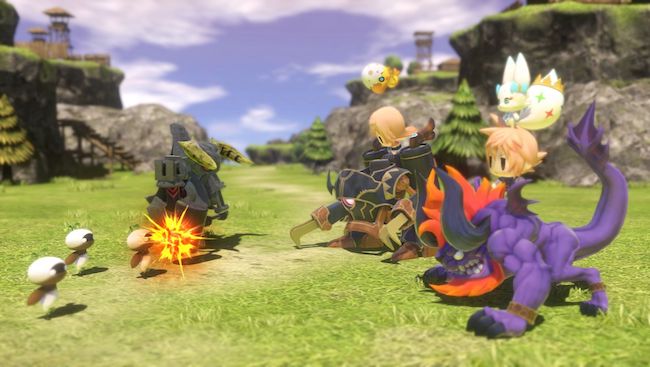
The biggest problem I have with WoFF is that if you look past the fan service and take a step back from its unique battle mechanics, the game is mostly just a linear and shallow romp through series’ nostalgia—at least until around 30 hours in where it finally opens up. For a large majority of the game, however, you’ll progress in what is essentially a cleverly disguised straight line that runs from one token encounter to the next, moving through towns which have almost nothing to do in them, and dungeons that are not particularly lengthy or inspired. I will admit the sense of nostalgia is quite exciting when you encounter reimagined versions of iconic locations such as Midgar and Figaro Castle, even if they’re basic in design and kind of wrong—don’t get me started on Nibelheim. However, the truth is that with only a limited number of buildings in most locations, nearly all of which you can’t enter, and perhaps the odd NPC who’ll give you a cookie-cutter side quest which awards items you probably don’t need, towns serve no purpose other than to create pretty scenery for players to pass through.
Almost everything meaningful you can do takes place in Nine Wood Hills, which is also pretty baron like the rest of Grimoire, but serves as your the main hub throughout the course of the game. Here you can buy and sell items, test your skill at the Colosseum (including online multiplayer, which is a kind of neat feature), visit the twins bedroom to read through all the hilarious character and monster descriptions, or teleport to “The Girl’s Tearoom,” which is a realm that exists outside of space-time where you can take on one the game’s most enjoyable features: Intervention Quests.
As you play through the game, you earn a special currency which can either be used to purchase Champion Medals that can be used to summon iconic Final Fantasy characters in battle, or to unlock side stories based around the various Final Fantasy characters you meet throughout the story. In most cases, these quests involve the twins being magically inserted into the place of various characters to take on some challenge on their behalf. It’s pure fan service, filled with tongue-in-cheek writing, great character mash-ups and humorous scenarios. While many of the encounters with Final Fantasy characters seem brief or inconsequential at first, this is something that changes after the game world opens up and you unlock the airship. It’s an incredible thing to see them all come together, even if by this point the plot starts to get bogged down with an overload of JRPG cliches; like something ripped out of a Kingdom Hearts spin-off. What’s important to know is that the game doesn’t actually end after your first beat it. There is a neat plot device that turns the story on its head, and what comes next is undoubtedly the most challenging and rewarding part of the game. It pays off, but it takes a lot of investment to get there.

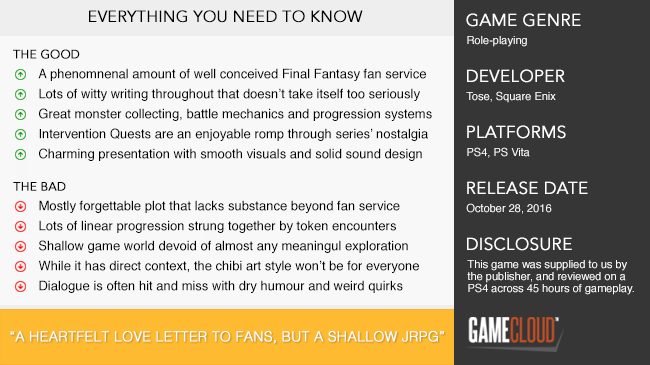
World of Final Fantasy is an endearing concept that had potential, which is why I wanted to love it a lot more than I did. Everything about it serves as a heartfelt letter to longtime fans such as myself, but the reality is that when you strip away the fan service, the game doesn’t have nearly as much to show for itself. Don’t get me wrong, it’s not bad by any means, just shallow. There are plenty of above average components such as fun monster collecting and solid battle mechanics, but a lot of the game’s best successes rely on your familiarity with the source material, which fails in its goal to bring in new players. Ultimately, a vast majority of the game is a linear romp from one token Final Fantasy encounter to the next with a bit of dungeon crawling to break things up. The game is devoid of almost any meaningful exploration, with it only finally opening up and pushing the plot forward once it’s much too late in the experience. If you’re willing to persevere, the payoff is worth it, but unless you’re in it for the fan service, you might be disappointed.











